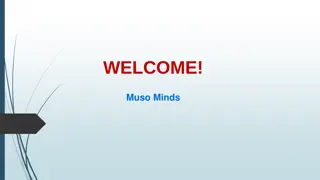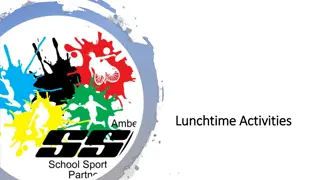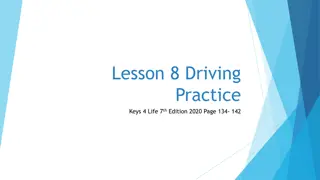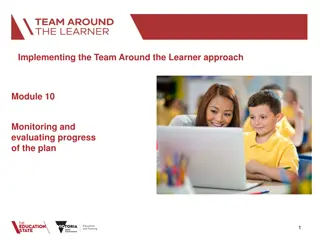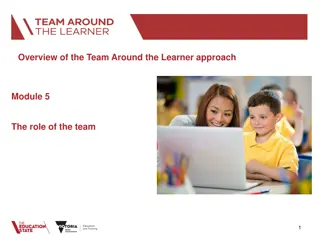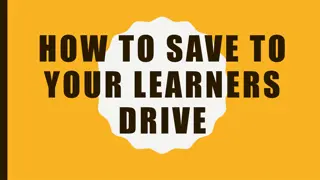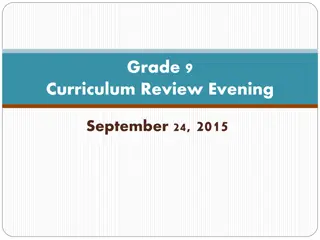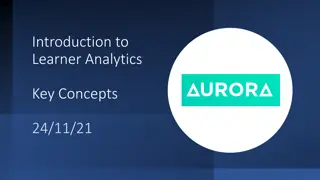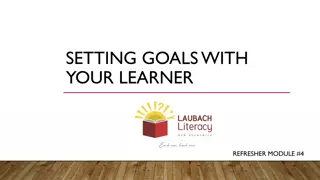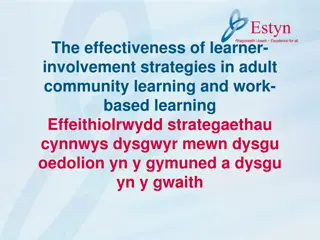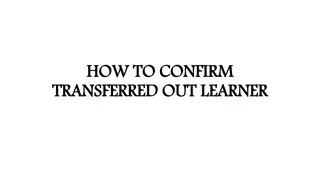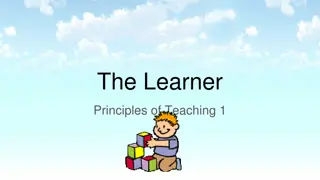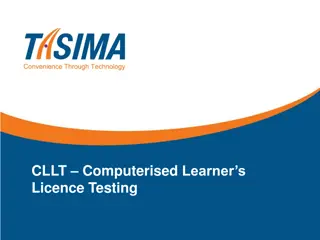English Learner's Guide to Health Care and Healthy Living Lunchtime Lessons
This guide provides a comprehensive 4-week program on health care and healthy living for English learners. It covers topics such as visiting a doctor, understanding emergency situations, and different kinds of health care services. The lessons emphasize the importance of regular checkups, recognizing symptoms when sick, and knowing how to handle emergencies like calling 911. Students will learn practical tools and resources for maintaining their health and well-being.
Download Presentation

Please find below an Image/Link to download the presentation.
The content on the website is provided AS IS for your information and personal use only. It may not be sold, licensed, or shared on other websites without obtaining consent from the author.If you encounter any issues during the download, it is possible that the publisher has removed the file from their server.
You are allowed to download the files provided on this website for personal or commercial use, subject to the condition that they are used lawfully. All files are the property of their respective owners.
The content on the website is provided AS IS for your information and personal use only. It may not be sold, licensed, or shared on other websites without obtaining consent from the author.
E N D
Presentation Transcript
STAYING HEALTHY AN ENGLISH LEARNER S GUIDE TO HEALTH CARE AND HEALTHY LIVING LUNCHTIME LESSONS 90 MINUTES FOR 4 CONSECUTIVE WEEKS Health Care The Doctor Medicines Nutrition
STAYING HEALTHY LESSON 1: HEALTH CARE Lisa Leiby, RN
HEALTH CARE Learning Objectives Students will list 3 reasons for visiting a doctor for a checkup Students will recognize emergency health care situations and when to call 911 Students will know where they can find local programs and facilities they can contact for health care Tools required: handouts, access to internet, healthy lunch/snacks
HEALTH CARE Health Care System Hospitals, Medical Clinics, Public Health and Emergency Departments Doctors, Nurse Practitioners, Physician Assistants Nurses, Dieticians, Pharmacists, Social Workers
HEALTH CARE Different Kinds of Health Care 1) Regular Checkups Well Visits Health or Medical History Form (p. 30 handbook) Check Yes or No Specific dates/year of illnesses, immunizations Physical Examination Height and Weight and Blood Pressure Heart Lungs Eyes/Ears/Throat/Mouth Tests: blood, urine, (female) pap smear, (male) prostate Staying Healthy Diet Exercise No Smoking Immunizations
HEALTH CARE 2) When you are sick Symptoms Tell doctor how you feel and for how long Contagious Diseases You get sick from other people s germs Good Hand Washing! Hospitals and grocery stores have hand wipes Making an Appointment (Role play)
HEALTH CARE 3) Emergency Visits 911 Chest pain Difficulty Breathing Car Accident Drowning Snake bite Unconscious Use any phone to call 911 immediately Tell what the emergency is Answer all questions If you do not understand, say I speak Spanish , wait for someone who speaks your language DO NOT HANG UP the phone Wait with the sick person until the ambulance arrives
HEALTH CARE Learning Medical Words Vocabulary Words Pronunciation: Tap the Stress (p. 7 Teacher s Guide) Activities: Health Care Vocabulary Bingo (www.bingocardcreator.com) Hospital Signs and Symbols (p. 12 handbook) Phone Call: 211 or access website @ www.flairs.org Community Health Care Resources (handout) www.healthyroadsmedia.org/index.htm
HEALTH CARE Conversation 1: (Role play) Operator: 911. What is your emergency? Parent: My boy fell out of the tree. Operator: Is he conscious? Parent: Yes. Operator: Is he hurt? Parent: I think he broke his leg. Operator: An ambulance is on its way.
HEALTH CARE Conversation 2: (Role play) Information Desk: May I help you? Patient: Yes, where do I go for an X-Ray? Information Desk: Do you have an appointment? Patient: Yes. Information Desk: You need to go to Radiology. Go past the gift shop and turn right. Look for the X-Ray sign. You will need to sign in at the desk. Patient: OK. Thank you.
STAYING HEALTHY: LESSON 2: THE DOCTOR Lisa Leiby, RN
THE DOCTOR Learning Objectives Students will identify 2 helpful ways to prepare for a doctor s appointment Students will know 3 important questions to ask the doctor Students will describe 8 common symptoms clearly Tools required: b/p machine or cuff and stethoscope, handouts, access to internet, healthy lunch/snacks
THE DOCTOR Things To Do Before Your Doctor s Visit Write down the medicines you take or bring the medicines with you Write down all of the health problems you have ever had and the symptoms you are feeling now Practice describing your symptoms in English Bring bilingual book Ask a friend or family member to go with you Request interpreter
THE DOCTOR The Doctor s Office Visit (Role play) Sign in Tell clerk your name and time of your appointment Fill out Health History Form Wait in the waiting room until the nurse calls you to take your: Height Weight Blood Pressure (take B/P from each student) Nurse will ask you to undress and wear a gown The doctor will knock on the door and come in with the nurse or medical assistant Tell the doctor why you are there and describe your symptoms Examination
THE DOCTOR Vocabulary Words Pronunciation Tap the Stress (p. 27 Teacher Guide) Describing Symptoms/Health History (p. 31 Teacher s Guide) Activities Conversation: Information Desk or phone Math: Understanding Blood Pressure (p. 28 Teacher s Guide) Grammar: (p. 29-30 Teacher s Guide) Feel Have and When After and Have You Ever Practice Describing Symptoms (p.23-27 handbook) www.eslpod.com Describing Symptoms to the Doctor Conversation with the Doctor
THE DOCTOR Conversation 1: (Role play) Doctor: I m Dr. Robbins. How are you today? Patient: OK, thank you. Doctor: What can I do for you today? Patient: I feel dizzy and I have a headache. Doctor: How long have you been feeling dizzy and have had a headache? Patient: For a week. Doctor: Do you have a history of high blood pressure? Patient: Yes. Doctor: Are you taking any medications for your blood pressure? Patient: No. Doctor: Is there anyone in your family with high blood pressure? Patient: Yes, my mother and my grandmother.
THE DOCTOR Conversation 2: (Role play) Doctor: You have mild hypertension. I m going to write you a prescription for medication. Patient: Excuse me, but I don t understand. Doctor: Hypertension means high blood pressure. Your blood pressure is a little too high, so I want you to take some medicine to bring your blood pressure to a normal level. Patient: OK, thank you for explaining that. Doctor: You re welcome. I want to schedule a follow-up appointment in 6 weeks to see if the medicine is working. Patient: OK, thank you.
STAYING HEALTHY: LESSON 3: MEDICINES Lisa Leiby, RN
MEDICINES Learning Objectives Students will understand the difference between over-the-counter and prescription medicines Students will know how to find and understand 6 pieces of information on a prescription label Students will explain how to take medicines from reading the directions on the label Tools required: variety of empty prescription/OTC bottles/pkgs, tsp/Tbsp, syringes for demonstration, handouts, access to internet, healthy lunch/snacks
MEDICINES Different Types of Medicine (p. 39-40) Prescription Over The Counter (OTC) Different Kinds of Medicine (p. 37) Tablets, liquid, powder, drops, injection, inhalant, ointment, capsules Hands-on demonstration with variety of medicines
MEDICINES Medicine Labels Over the Counter (OTC) 1. Name of the medicine 2. What is the medicine for 3. How and when to take the medicine 4. How much of the medicine to take 5. Side effects 6. Warnings 7. Expiration date (end)
MEDICINES Medicine Labels Prescription 1. Name of medicine 2. Dose = how much medicine to take 3. Prescription Rx # 4. Pharmacy phone number 5. Date when you receive medicine 6. Number of refills 7. Your name and your doctor s name
MEDICINES How to measure and take medicine All medicine labels give directions: How to take the medicine Oral - mouth Rectal - rectum Topical skin Optical eyes Inhalant - lungs
MEDICINES How much medicine to take 1 tablet, 2 tablets, tablet 1 capsule, 2 capsules 1 teaspoon, 2 teaspoons, teaspoon
MEDICINES How often or when to take the medicine Once a day 8 am Twice a day 8 am and 5 pm Three a day 8 am, 5 pm, 8 pm Every 4 hours 6 am, 10 am, 2 pm, 6 pm, 10 pm Every 6 hours 6 am, 12 pm, 6 pm, 10 pm
MEDICINES Taking Medicine tablets, capsules, liquid Vocabulary Words Pronunciation Tap the Stress (p. 43 Teacher s Guide) Activities Grammar: How much, How many, How often (p. 44 Teacher s Guide) Hands on: Reading Medicine Label Measuring Liquid Medicines Side Effects Warning Labels (p. 45) www.reepworld.org/englishpractice/health/medicine/index.htm
MEDICINES Conversation 1: (Role play) Patient: What is my problem? Doctor: You have an infection. The medicine I give you will kill the infection. Patient: What do I need to do? Doctor: Start taking the medicine right away. Take it for the entire 14 days, even if you think you are feeling better. Patient: Why is that important for me to do that? Doctor: The medicine is an antibiotic. You need to take all of it so the infection will not return.
MEDICINES Conversation 2: (Role play) Pharmacist: How may I help you? Patient: I need to fill this prescription, please. Pharmacist: OK. Here you are. Do you have any questions? Patient: Yes. How do I take this medicine? Pharmacist: Take 2 capsules twice a day. Patient: When should I take them? Pharmacist: Take 2 capsules in the morning and 2 capsules in the evening. Patient: OK. Thank you.
STAYING HEALTHY: LESSON 4: NUTRITION Lisa Leiby, RN
NUTRITION Learning Objectives Students will explain 2 ways how nutrition affects your health Students will describe the function of 5 important nutrients, and name foods that contain them Students will identify 4 important pieces of information on a food label Tools required: variety of food packages with food labels, handouts, access to internet, healthy lunch/snacks, recipes
NUTRITION How the body uses food to stay healthy Good nutrition helps the body to: (p. 52) Grow Stay Strong To Have Energy Fight Sickness and Disease All foods contain 3 important nutrients: (p.53-57) Carbohydrates, Proteins, Fats Fiber, Vitamins, Minerals Healthy Eating (p. 57-58) Variety Eat 5-9 Servings of Fruits/Vegetables Every Day Less fat Less sugar
NUTRITION Food Labels and Nutrition Facts Vocabulary Words Pronunciation Tap the Stress (p. 59 Teacher s Guide) Activities Comparing Labels/Choose Healthier Foods 1. Serving size: (p. 62) 2. Calories 3. Total Fat 4. Carbohydrates/Fiber Grammar: Words that Mean the Same Thing (p.63) Hands on: Looking at Food Labels and Grouping Healthy Weight www.choosemyplate.gov www.fruitsandveggiesmatter.gov
STAYING HEALTHY Eat Healthy Foods Keep a Healthy Weight Exercise Don t Smoke Get Regular Checkups Take Care of Stress www.healthyroadsmedia.org
5 SUPER FOODS 1) Spinach - high in Vitamin K good for bones and vision 2) Curry turmeric decreases brain aging, cancer and boosts metabolism 3) Tomatoes Lucopein great antioxidant and decreases skin damage while in sun 4) Almonds Vitamin E good for coordination and decreases heart disease 5) Dark Chocolate great antioxidant decreases blood pressure and heart disease





